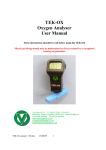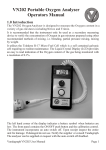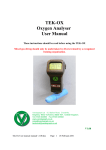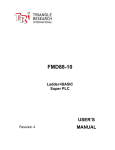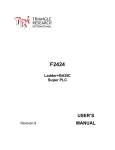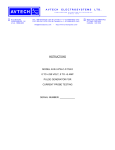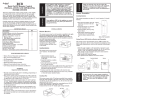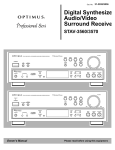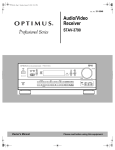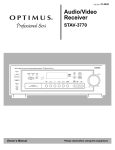Download AN20MA-2 Installation Guide
Transcript
AN20MA-2 20mA Current-Voltage Interface Board PLC’s Power Supply +24V 0V AN20MA-2 DAC #1 (0-20mA) DAC #2 (0-20mA) DAC #3 (0-5V, buffered) DAC #4 (0-5V, buffered) Analog Reference (Buffered) Analog Ground (0V) ADC ADC ADC ADC DB15 cable #1 (0-20mA if DIPSW-1=ON) #2 (0-20mA if DIPSW-2=ON) #3 (0-20mA if DIPSW-3=ON) #4 (0-20mA if DIPSW-4=ON) ADC #5 (0-20mA, always) ADC #6 (0-20mA, always) ADC #7 (0-20mA, always) ADC #8 (0-20mA, always) Detachable screw terminal block. 2 Mounting Holes (fits 1/2 DIN-KIT-2) Figure 1 - AN20MA-2 – 2/8 channels Analog Current loop Interface Board 1. Introduction The AN20MA-2 is designed to connect easily to a FMD or F-series PLC and converts up to 2 channels of 0-5V analog output voltage from the PLC to 0-20mA current loop for controlling external 0-20mA or 4-20mA devices. AN20MA-2 also converts up to 8 channels of 0-20mA or 4-20mA analog signals from field devices, remote sensors or other controllers into 0-5V analog input signals that the FMD or F-series PLC accepts. 2. Physical Mounting & Wiring Each AN20MA-2 board has two 1/8” (3mm) diameter mounting holes which allow it to be easily mounted on copper or Nylon standoffs. Note that the two mounting holes are spaced 4.200 inches apart, which is identical to that found on the FMD and Fseries PLCs. This means that the AN20MA-2 can be mounted readily on a DIN-Rail using ½ pack of DIN-KIT-2 (http://www.tri-plc.com/DINkit.htm) or 1/3 pack of DIN-KIT-3. 1 AN20MA-2 Current-Voltage Interface Installation Guide It is easier to mount the AN20MA-2 on the left hand side of any FMD or F-series PLCs and connect it to the PLC’s analog interface connector (DB15 female) using the 1foot (30cm) long DB15 male-to-female connecting cable (included). Once the DB15 cable is connected, the analog inputs and output signals from the PLC become available on two detachable screw terminal blocks, making connection to field devices much easier. Each block of screw terminals can easily be detached from the controller body, enabling easy replacement of the controller board when necessary. Since the terminal block for digital I/O is inserted vertically to the board surface, you need to remove the terminal block before you can start wiring. Use a small flat-head screwdriver and insert it underneath the terminal block, applying even pressure to raise the terminal block until it becomes loosened from the connecting-pin strip, as shown below: Insulated crimp ferrules Tightening screw Connecting-pin strip Flat-head screw driver Figure 2 - Removing Screw Terminal block Although you can connect a single or multi strand wire directly to the screw terminal, we strongly recommend using the insulated crimp ferrules to provide a good end termination to multi-stranded wires. Using ferrules reduces the possibility of stray wirestrands short-circuiting adjacent terminals and their use is therefore highly recommended. 3. Power Supply The AN20MA-2 requires a 12 to 24V DC power supply to power its 20mA current loop outputs. Please use only industrial grade linear or switching regulated power supply from established manufacturers for best results. You may connect it to the SAME 12 to 24V power supply as the PLC if the PLC power supply is well regulated and provides clean current to the devices. The power supply is to be connected to the detachable screw terminal as shown in Figure 1. Note: the DC power supply voltage affects the maximum compliant voltage that the 20mA current loop can deliver. 2 AN20MA-2 Current-Voltage Interface Installation Guide Always place the power supply as close to the PLC and the interface board as possible and use separate wires to connect the power to I/O. Keep the power supply wire as short as possible and avoid running it alongside high-current cables in the same cable conduit. 4. Analog Output Interface DAC # 1&2 3&4 Analog Ref. Type Voltage-to-current loop converter Buffered voltage-follower Buffered voltage-follower Output Signal 0-20mA current loop 0-5V or 0-10V (same as PLC) 5V or 10V (same as PLC) Voltage-To-Current Loop Converter Outputs The 0-5V analog output #1 & #2 from the FMD or F-series PLCs is converted to 020mA current loop output. To interface to other types of devices that expect 4-20mA, you simply program the DAC to output 1V to 5V. Notes: • When connecting to FMD88-10 or FMD1616-10, ensure that the DAC #1 & 2 are configured for 0-5V and not 0-10V outputs. • When connecting to F1616-BA, the value used by SETDAC command for DAC #1 & 2 should be limited to 0 to 2048, which will limit the output to 0-5V (since F1616-BA can only output 0-10V DAC) Buffered Voltage-Follower Output AN20MA-2 provides 3 x unity-gain buffered amplifiers (aka voltage-follower) for DAC #3, DAC #4 as well as the analog reference AVcc signal from the PLC. Since the output voltage of a unity-gain buffered amplifier is exactly the same as the input voltage, DAC#3 and #4 on the screw terminal follow the same voltage as the signal output from the PLC via the DB15 connector. However, the buffered amplifier has the advantage of providing low impedance outputs to the screw terminal and the ability to source up to 30mA per output. This is particularly useful for the DAC#3 and #4 from the FMD88-10 and FMD1616-10 PLCs since these two DACs are high impedance outputs. The AN20MA-2 provides these two analog outputs with a low impedance buffer and offers protected interface to the fragile analog output pins of the PLC. 3 AN20MA-2 Current-Voltage Interface Installation Guide 5. Analog Input Interface ADC # 1– 4 5–8 Type 250 Ohm resistor, or pass through Signal Conversion DIPSW 1-4 ON : 0–20mA –> 0–5V DIPSW 1-4 OFF : no change 250 Ohm resistor 0–20mA –> 0–5V Current Loop-to-Voltage Conversion The simplest means of converting a 0-20mA (or 4-20mA) current loop signal to 0-5V range is to connect a 250 ohm load to the current loop and then measure the voltage drop across the load (20mA x 250 ohm = 5V) using the PLC’s analog input. On the AN20MA-2 interface board, 8 x 250 ohm resistive loads are provided to convert 8 channels of 20mA current loop input signals to voltage signals. Of these, analog inputs #1 to #4 can optionally be disconnected from the 250 ohm resistors by pushing the respective DIP Switch to the OFF position. E.g. if you wish to disconnect ADC input #3 from the screw terminal block to the 250 ohm resistor, then just turn DIP switch #3 to the OFF position. When the DIP switch is OFF the corresponding signal from the screw terminal is directly passed through to the DB15 connector. ADC #5 to #8, on the other hand, are hard-wired to the 250 ohm resistors and therefore cannot be disabled (except by de-soldering the resistors). However, a low impedance voltage source that can source more than 20mA current can still be connected to ADC #5 to #8 even with the 250 ohm resistors in place. Recalibration of Analog Input Note that some of the analog inputs (e.g. ADC 7 & 8 on FMD PLCs, ADC5-8 on F2424 and ADC 1-8 on F1616-BA) are of low impedance type (20K Ohm or 40K ohm). When a 20mA current loop is converted to 5V signal as described above, the 250 ohm resistor is effectively connected in parallel to the input impedance. This can affect the accuracy of the analog reading since the resulting resistance is slightly lower than 250 ohm and the converted voltage will be lower than the correct voltage. You can correct the error by re-calibrating the analog input using the “Ethernet & ADC Configuration Tool” and following the procedure described in the PLC User’s Manual. 4





